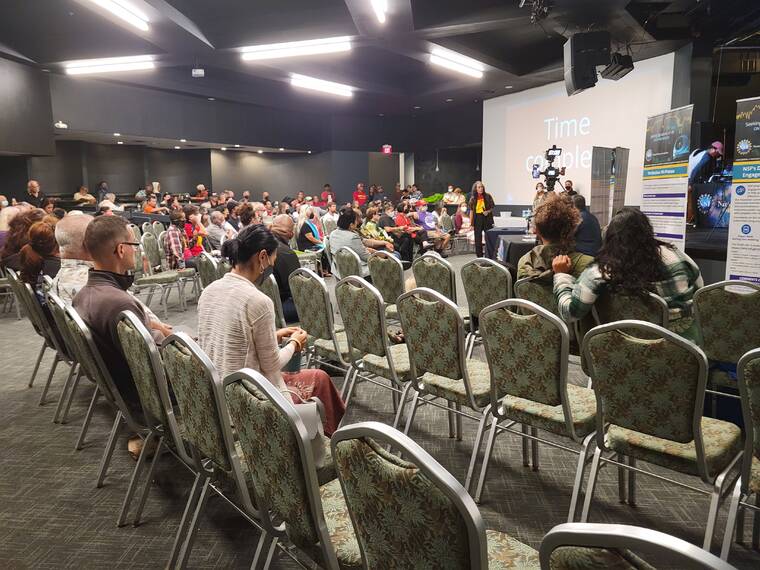Testifiers blast TMT project

Attendees wait to testify at the NSF public scoping meeting Tuesday at the Grand Naniloa Hotel. (Michael Brestovansky/Hawaii Tribune-Herald)

TRASK

BOBOLTZ
The first public meeting to determine whether to award federal funding to the Thirty Meter Telescope ended Tuesday after four hours of outrage.
The first public meeting to determine whether to award federal funding to the Thirty Meter Telescope ended Tuesday after four hours of outrage.
Representatives from the National Science Foundation held the first of four public meetings on the Big Island to determine the scope of an eventual environmental review for the TMT project. Nearly 100 people filed into the Crown Room at the Grand Naniloa Hotel in Hilo for what was scheduled to be a two-hour meeting.
Instead, the meeting went on for four hours, with dozens of attendees taking the stand to decry the process, the NSF, the University of Hawaii and TMT specifically.
“Listen to what we are saying,” said Mililani Trask, Big Island trustee for the Office of Hawaiian Affairs, in a fiery 10-minute criticism. “We have tolerated (commercial science) to the point where our kupuna will be arrested and thousands will come. You will not persevere. You will not build on Maunakea … and if showing you 20,000 (people) and 36 kupuna going to prison didn’t show you that, then come back, and we’ll have 50,000 and hundreds of kupuna.”
Last year, a decade-long analysis of the current state of astronomy urged the United States to invest in an “Extremely Large Telescope Project” that will compete with similarly sized projects being built by European organizations. This ELT would include the TMT, although NSF Assistant General Counsel Caroline Blanco said at the meeting Tuesday that no decision about the telescope has been made.
“This is just the very beginning of a process that helps us figure out what we are going to study,” Blanco said. “Our role is to consider whether there will be a decision to fund or not fund (TMT). NSF has not made any decision at all, and NSF could actually decide not to do the environmental review and could back out at any time.”
Dave Boboltz, program director for NSF’s Division of Astronomical Sciences, said NSF is considering four options for the TMT: to build on Maunakea, to build on the Canary Islands in Spain, to build on Maunakea with a “plan to define and practice responsible astronomy in Hawaii” — a phrase which elicited snickers from the audience — or to not build it at all.
Testimony at the meeting greatly favored the last option. Attendees raised myriad concerns — from the telescope’s potential impacts on aquifers beneath Maunakea, to institutional racism embedded in the NSF funding process, to fears of a Chinese scheme to spy on the Pohakuloa Training Area — but most cited decades of anguish caused by repeated exploitation and disregard for Hawaiian cultural practices.
“I’ve had a lot of contact with scientists over the years as a member of that community,” said Volcano resident Tom Peek. “But sadly I’ve come to the conclusion that, at least in their professional roles, these men and most astronomers I’ve talked to over the years are disrespectful of the facts and, indeed, probably ineducable. They have deigned to talk to Native Hawaiians and other islanders in an effort to manufacture the illusion of consent, but have proved themselves incapable of meaningful compromise.”
Some testifiers suggested alternatives to building the TMT. One suggested simply continuing an NSF grant program that incorporates Native Hawaiian cultural perspectives into astronomy education, while others questioned the worth of further space observation at all.
But with dozens signed up to testify, and most taking longer than their allotted time to finish their comments — Blanco said at the beginning that she would not enforce time limits on testifiers — the meeting stretched past its planned 8 p.m. end time for another two hours.
There also were some disruptions during the meeting. At 9 p.m., the meeting halted briefly after a fire alarm was triggered within the hotel. It was quickly determined to be a false alarm, although several attendees reacted to the alarm with incredulity, evidently suspecting that it was a ploy to silence negative testimony.
After that, shortly before the end of the meeting, gubernatorial candidate and retired mixed martial arts fighter B. J. Penn walked up and seized the microphone.
“On Dec. 1, 2022, I will be the governor of Hawaii,” Penn said. “When I’m the governor of Hawaii, I will go into the Department of Land and Natural Resources and end the corruption. I will go into the Department of Hawaiian Home (Lands) and end the corruption. I will go into the Hawaii State Supreme Court system and end the corruption. And then I will end TMT.”
Although several representatives of the Maunakea Observatories were present during the meeting, none spoke during the four hours of testimony. Only one person testified in support of the project, but even she said she knew it would not be built — “but at least I tried,” she said.
After Tuesday’s meeting and a second one on Wednesday in Naalehu, there will be two more public scoping meetings: at 6 p.m. today at the Outrigger Kona Resort in Kailua-Kona and at 6 p.m. Friday at Kahilu Town Hall.
People can submit comments to the NSF regarding the scoping meetings, and regarding the NSF’s Draft Community Engagement Plan, at beta.nsf.gov/tmt.
Email Michael Brestovansky at mbrestovansky@hawaiitribune-herald.com.


